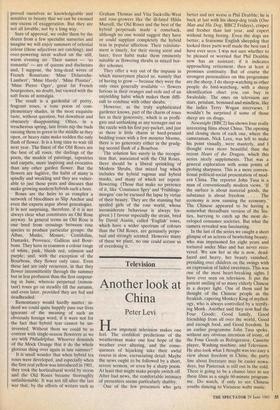Gardens
Overdoing it with roses
Ursula Buchan
The end of June is the time, par excellence, for overdoing it in the garden. Not, that is, overdoing the work, although there is plenty of that, but overdoing the adjectives. 'How I do love the Old Shrub Roses, they are so beautiful, so fragrant, so sumptuous, so much the colour and texture of velvet, don't you agree?' The enthu- siasm, I am sorry to say, faits little short of gush. The assumption that the expression of such passion serves as a sign of sophis- tication, of a coming of age as a gardener, is no excuse at all. Rather the reverse. It is too easy to feel that by turning out of their beds all those stiff-branched, glossy- leaved, hybrid teas with their pointed 'flame', 'salmon' and 'bi-coloured' flowers and welcoming in the Old Roses we have proved ourselves so knowledgeable and• sensitive to beauty that we can be excused any excess of exaggeration. But they are not all lovable, not by a long way.
Sure of approval, we order them by the dozen from a few specialist nurseries and imagine we will enjoy summers of celestial colour (these adjectives are catching), and over-powering scent wafted on the still, warm evening air. Their names — `so romantic' — are of queens and duchesses and, I suppose, the long-dead wives of French Rosarians: `Mme Delaroche- Lambert', `Mme Hardy', `Mme Plantier', `Mme Pierre Oger', great fat French bourgeoises, no doubt, but viewed with the soft focus of nostalgia.
The result is a gardenful of pretty, fragrant roses, a tone poem of com- plementary shades, in the most exquisite taste, without question, but downbeat and obscurely disappointing. Often, in a treacherous spring, late frosts nip the buds causing them to green in the middle as they open, or heavy rains make sodden the only flush of flower. It is a long time to wait till next year. The finest of the Old Roses are the best of all roses, the darlings of the poets, the models of paintings, tapestries and carpets, more inspiring and evocative than any other garden flower. But the flowers are fugitive, the habit of many is spindly and weakling and they are vulner- able to just those pests and diseases that make growing modern hybrids such a bore.
Roses are the heirs to as complex a network of bloodlines as Slip Anchor and even the experts argue about genealogies. It is not surprising, therefore, if it is not always clear what constitutes an Old Rose anyway. In general terms an Old Rose is one bred from crossings between rose species to produce particular groups: the Albas, Musks, Mosses, Centifolias, Damasks, Provence, Gallicas and Bour- bons. They have in common a colour range of white, pink, bluish red, crimson and purple; and, with the exception of the Bourbons, they flower only once. Even these last are only recurrent, in that they flower intermittently through the summer but in less profusion than the first outpour- ing in June, whereas perpetual (remon- tant) roses go on steadily till the autumn, and even later, provided they are fed and deadheaded.
Remontancy would hardly matter, in- deed we could quite happily pass our lives ignorant of the meaning of such an
obviously foreign word, if it were not for the fact that hybrid teas cannot be un- invented. Without them we could be as content with single-season flowerers as we are with Philadelphus. Whoever demands of the Mock Orange that it do the whole glorious thing over again in late summer? It is small wonder that when hybrid tea roses were developed, and especially when
the first real yellow was introduced in 1901, they took the horticultural world by storm and the Old Roses became thoroughly unfashionable. It was not till after the last war that, by the efforts of writers such as Graham Thomas and Vita Sackville-West and rose-growers like the ill-fated Hilda Murrell, the Old Roses and the best of the hybrid perpetuals made a comeback, although no one would suggest they have or could supplant completely the hybrid teas in popular affection. Their reinstate- ment is timely, for their strong scent and laxer, freer habit make them eminently suitable as flowering shrubs in mixed bor- der schemes.
They offer a way out of the impasse in which nurserymen placed us, namely that of having to grow — because they were the only ones generally available — flowers furious in their oranges and reds and of an unyielding habit which makes them diffi- cult to combine with other shrubs.
However, as the truly sophisticated gardener knows, part of the charm of roses lies in their generosity, which is as profli- gate and unthinking as any teenager out on the razzle with his first pay-packet, and just as there is little charm in hard-pruned bedding roses with a few monster blooms, there is no generosity either in the grudg- ing second flush of a Bourbon.
The solution lies surely in the recogni- tion that, associated with the Old Roses, there should be a liberal sprinkling of Modern Shrubs, that mixed bag which includes the hybrid rugosas and hybrid musks, and many of which are repeat- flowering. (Those that make no pretence of it, like 'Constance Spry' and Priihlings- morgen' can be excused the lapse by virtue of their beauty. They are the stunning but spoiled girls of the rose world, whose inconsiderate behaviour is always for- given.) I favour especially the strain, bred by David Austin, called 'English' roses, which have a wider spectrum of colours than the Old Roses, are genuinely perpe- tual and strongly scented. However many of these we plant, no one could accuse us of overdoing it.



























































 Previous page
Previous page